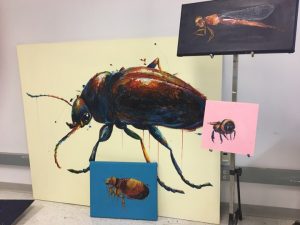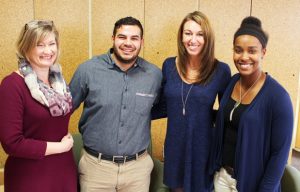
Nov 18, 2017 | Feature |
By Lindsay Mower – Staff Reporter
When Farmington native and Biology Major Hailey Mealey isn’t outside collecting bugs for the entomology course she’s enrolled in this semester, she will most likely be found crafting works of art for Hailey Jane Creations, the grassroots art business she started up last fall.

Biology Major and local artist Hailey Mealey. (Photo by Waylon Wolfe Photography)
Creating art has been a consistent outlet for expression for Mealey, though she became increasingly inspired to turn her passion into a way to sustain herself financially through the persuasion of her family, who encouraged her that people would most definitely be interested in buying her artwork. “I’ve always made art because it’s just something I super love,” said Mealey.
Mealey says she always thought that no one would be interested in her artwork. “My family would always try to convince me to sell my work, and I would be like, guys, no one wants to buy an eight-foot painting of an eyeball turning into a lizard,” she laughed, adding, “I don’t know a lot of people in the market for that.”
Having her high school art teacher at Mount Blue High School, Roger Bisaillon, as a mentor also played a pivotal role early on in encouraging Mealey that she had a gift that had potential. Bisaillon, who recently retired, and his wife are both successful local artists in Farmington. “I was really lucky to have him in class,” said Mealey. “He really guided me through that period of development and was always so supportive: he still is.”
After graduating from Mount Blue High School in 2014, Mealey studied Art Education at the University of Maine at Orono for a year before deciding to transfer back to her hometown university to pursue her passion for Biology. “Sometimes I get a little hometown-angsty being back in the area, but the Biology program is so great here and all the professors and students are so nice. There is a different atmosphere returning than having grown up here,” said Mealey.

Paintings from Mealey’s bug series. (Photo Courtesy of Hailey Mealey)
Though she is now studying Biology, Mealey hasn’t given up making art, she has even found a way to effortlessly combine her pair of passions. “I realized that what I was learning at Orono wasn’t what I loved about art… I love Biology. It’s just such a wide field, I can do so many things with it, and it’s inspired a lot of my artwork too.” Mealey smiles as she describes the bug series she has been working on, influenced by her love for the outdoors and the entomology class she is currently taking.
The idea to create her own business sprung to life around the time she left her job, according to Mealey. “I wanted to be able to focus on school, while still doing the things I enjoy, and I was just in a really unhappy place,” she said.
For Christmas Mealey painted some watercolor portraits of her and her siblings for her Grandparents and uploaded them to Facebook to demonstrate a custom gift she could make for someone else as a means to make some money. To her surprise, the post caught attention immediately. She began to successfully sell some of her work on Etsy, and has since launched her own website at haileyjaneco.com.

Mealey’s Maine inspired creations. (Photo Courtesy of Hailey Mealey)
Along with Mealey’s zany creations like eyeballs morphing into lizards, her creations take on many different themes. Facebook users may have stumbled across her popular watercolor designs in their newsfeed, like her rainbow painting of Bernie Sanders that she posted last year around the election, or her Maine-centric art. One of her more recent works features an outline of the state of Maine featuring a watercolor painting of ‘It’ from the Stephen King movie released earlier this fall painted inside.
As the holiday season approaches, Mealey has been balancing her class work with fulfilling custom orders. Although she will be busy for the next few weeks, she will be accepting orders again very soon. She can be contacted on her Facebook page under Hailey Jane Creations.

Oct 1, 2017 | News |
By Lindsay Mower – Staff Reporter
Rustic Roots Farm on Route 2 in Farmington recently held a double elimination cornhole tournament with all proceeds going to growing fresh, local produce for seniors in the Farmington and Jay areas.
The event took place under a blue sky in the courtyard of Uno Mas with 12 teams competing to win the grand prize of a set of homemade cornhole boards and a gift card to Uno Mas, donated by the Mexican inspired restaurant on Front Street. The afternoon featured live music from Lauren Crosby, a recent UMF graduate from Georgetown, Maine, who played an acoustic, folksy set on the small outside stage.
Erica Emery and David Allen, partners of Rustic Roots Farm, reported that they raised close to $350, which will fund three senior farm shares for next season.
“Our goal is to expand the senior farm share program into other areas of Franklin County and include more farms who can provide produce to seniors in their area,” said Emery. “We need more senior farm shares in our area because many seniors do not have access to fresh and healthy produce on a regular basis. By pairing seniors to farms who are growing local produce in season, it is increasing access to healthy food.”
Brian Wardwell, Philosophy and Religion major who works for Rustic Roots Farm and helped put the event together, says that events like this help strike a certain festive vibe in the atmosphere of the Farmington area, which he believes can only lead to good.
“I feel that little actions like this can help to restore some faith in humanity for those they may otherwise not have it. As they say, piece of mind is priceless,” said Wardwell. “The hope is that this particular effort will help seniors by providing them with fresh, wholesome vegetables… something that’s not necessarily affordable or in abundance.”
Father Paul Dumais, the priest at St. Joseph’s and St. Rose, was generous in supporting this effort on behalf of both churches and says he’s happy to have done it. “I am grateful to Erica and the staff at Rustic Roots for the partnership that provides fresh produce for seniors in the community,” said Dumais. “I remember how important their garden was to my grandparents and know it was a loss when they were not able to continue planting and harvesting. My hope is that seniors shares would continue and grow, which provides good food and a good connection to the community.”
According to Emery, the positive reaction had by the surrounding towns in supporting these efforts has led this to become an annual event. Wardwell says he is looking forward to the proliferation of a program that has the potential to help seniors and farms alike. “Although the team turnout was a bit on the low side, we were more than happy with the success of the event. It came together pretty seamlessly, and vibes were good through and through, which is really all we can ask for,” said Wardwell.
Wardwell says that people can continue to help and support causes like this by simply showing up for these kinds of events and gatherings, as well supporting the efforts of local farmers whenever possible. He jokes that it’s always good to get to know your farmer. “The grocery shelves are a certain bet, but have out for a little adventure! More than likely you’ll expand your food possibilities, or even make some new friends in the process.”

May 2, 2017 | Exclusive |

Left to right, Asst. Professor of Community Health Kelly Bentley; Community Health Ed students Ronie Morales, Melissa Boulette, Rhiannan Jackson. (Photo Courtesy of UMF Website)
By Lindsay Mower, Staff Reporter
Ronie Morales, a familiar face and accomplished Community Health Education major on UMF’s tiny liberal campus, is worth getting to know before he graduates this May. Known for his optimistic and infectious attitude, along with his commitment to the enrichment of the Western Maine community, Morales is one of the class of Spring ‘17’s finest.
Last semester, as a student in the Resource Management and Grant Writing course taught by Community Health Education professor Kelly Bentley, Morales and a group of his classmates secured a $5,000 grant for the Farmington Homeless Shelter. Morales said that the process for obtaining the grant for the shelter located on the Wilton Road was arduous, but was made easier with the help of fellow classmates Zach Bonnevie, Melissa Sawyer-Boulette, Tasha DeRoche, Rhiannan Jackson and Ryan Rice.
The group of students collaborated with the Board of Directors from the Western Maine Homeless Outreach. “We negotiated that we would use the ‘Rent Smart’ program, which is basically an education system for the homeless people teaching them how to maintain permanent housing and how to be smart when it comes to financial aid,” said Morales.
Morales believes that growing up witnessing living conditions in disadvantaged neighborhoods and experiencing an array of communities and cultures has helped him to better understand the fundamentals of public health, especially the need for grant money in areas of poverty. He was born in Houston, Texas, where he lived for eight years before moving to Guatemala, and uprooting again to Long Island, New York where he would remain until graduating from high school in 2013.
Along with his passion for healthcare, Morales is also a talented soccer player. His large involvement in the sport is what brought him to UMF. Morales was picked up by UMF recruiters to play soccer here his freshman year after given a positive reference by Zachary Sathasivam, a Psychology Major and fellow soccer player who graduated from UMF in 2015.
During his first semester at UMF Morales switched his major to Community Health Education almost immediately, forming a relationship with Community Health Professor Maurice Martin as a mentor. It was these types of very real connections made in Farmington that made him fall in love with this community. Morales says, “I like the students, the professors and the locals here,” adding, “everyone is willing to help you if you’re down low… everyone knows who they are here. Farmington, to me, is more like a family.”
Sofia Vanoli, a Spanish Teacher’s Assistant at UMF, has nothing but good things to say about Morales’ character as a community member and as a student. Vanoli, who has had him in the classroom, affirms his great interest in soccer and the culture surrounding the passionate sport. Vanoli says, “We all enjoy Ronie’s sense of humor,” she adds, “He’s very motivated in class and it shows that he likes participating.”
With an outstanding belt of minors in coaching, nutrition and child and adolescence, Morales has several options on his horizon for what he can do to put his impressive degree to good use. He would like to coach soccer and track and field at the middle school and high school level, but he also dreams of working in a more professional setting as a community health program coordinator or taking on a position at the Center for Disease Control (CDC) to build himself a more health-progressive career.
Morales says with a laugh that his future isn’t set in stone, though he plans to spend his Summer with family in South Carolina before returning to the Western Maine area to wrap up his internship this Fall. Given his resume, we can all be sure that Morales’ upcoming contributions to society will surely be good ones.
Apr 20, 2017 | News |
By Lindsay Mower, Staff Reporter
In 2017, humans in modern society find themselves in a contemplative state of addiction to a diversity of electromagnetic field (EMF) sources: i.e. mobile technology, which ex- poses them to various doses of radiation on a daily basis. This public health phenomenon, a large topic of discussion among UMF students in the classroom with Community Health Education professor Dr. Maurice Martin, can be supported by an article published online in 2012 by Myung Chan Gye and Chan Jin Park which examines the effects of EMF exposure on the reproductive system.
The findings of the article indicate that EMF exposure alters reproductive parameters of the human body, including male germ cell death, the estrous cycle, reproductive endocrine hormones, sperm motility and overall pregnancy success, among other areas. Of course, these biological effects differ according to frequency and wave, strength and duration of exposure.
Martin believes the implications of the article’s findings are of immediate concern. “A reduction in testosterone has the effect of making it a much more androgynous society, which is more likely to espouse a feminist paradigm,” says Martin. “It throws the balance of nature off. I think that masculine behaviors, that might not be positive all the time, certainly are needed at some points.”
Like any public health concern, there lies a political aspect to this invisible epidemic: the 1996 Telecommunications Act crafted under the Clinton administration, with help from The Wireless Industry, which states that no health or environmental concern can interfere with the placement of telecom equipment, such as cell towers and antenna.
“There was a motion put on the floor of the house in Washington saying that we really need to study the effects of electromagnetic radiation further. The house Republicans immediately came up with an embargo, or a block, against any reports that could identify health issues to stop the construction of cell towers and all mobile technology,” explains Martin.
For public health research purposes, this basically resulted in the federal government being prohibited in studying the effects of electromagnetic radiation if they want any kind of funding at all. This is why no research can be seen from the Centers for Disease Control and Prevention (CDC) or the National Institutes of Health (NIH). The 1996 act is still in place today.
In addition to EMF exposure remains a very visible health effect caused by modern society’s addiction to technology: a lack of physical activity. “There are only so many hours in the day. If you’re spending eight of those online, you don’t have much time to be physically active at all,” says Martin, warning that it should come as no surprise when we see the increased development of chronic disease in the near future. “We are going to start having fewer years in our life,” says Martin.
Acknowledging the reality, which is that most of our jobs and livelihoods depend upon this type of technology, Martin also believes it’s highly unlikely that we’re going to back up from it. “The type of addiction to technology that is seen in millennials has developed through the use of screen time from infancy, onward. I believe that there are pathways in the brain that are deeply rooted, and that have now been formulated for digital processing,” he says. “Myself, I’m not that interested, but I think that when little children learn it early on, it just becomes a habit. I don’t think that they can help it.”

Mar 9, 2017 | News |
By Lindsay Mower, Staff Reporter
Escaping Maine’s cold winter by traveling 7,800 miles to India, Community Health Education majors at UMF Minarva Craig and Bri Martin are spending their semester abroad studying and spreading health advocacy to local children and their families.
The pair are now settled into New Delhi where they are trying to fully immerse themselves into the culture by learning the basic vocabulary and eating the wide variety of foods.

Bri Martin dressed in traditional Indian attire (Photo Courtesy of Bri Martin)
For Martin, this adventure is a mental promise to embrace the physical chaos in India as she lives outside of the country for the first time. Craig, who grew up in Maine but was adopted as a baby from India, says she is excited to be spending her last undergraduate semester back in her homeland. “When I go to a village and see people I wonder if they may be someone I’m related to,” she said in an online interview. “I will forever thank my birth mother for doing what is best for me,” she said, “My mother in America is the best person I know.”
Craig and Martin have both created blogs where they are documenting their traveling experiences for their family and friends back home. Martin’s blog, “Finding Solace in the Chaos,” is dedicated to reflecting upon her new lifestyle as she deviates from her daily schedule of attending classes in Farmington. Quoting Brazilian lyricist and novelist Paulo Coelho who once said, “If you think adventure is dangerous, try routine; it is lethal,” Martin’s says in her blog post that while taking in the new spicy smells and admiring the intricate clothing patterns around her, she can now see that Coelho couldn’t have said it any better. “I am so beautifully disoriented; so immersed in beautiful chaos,” she says, “My inner stressed out perfectionist missed the flight, but I’m not terribly worried about it.”
Craig says that it’s sad to see the major health disparities she has witnessed among the families in New Delhi. Martin agrees, saying she feels slightly ashamed for not helping any of the people asking her for rupees, after being advised not to for safety reasons. “On a practical level, I understand. On an emotional, and spiritual level, I simply cannot comprehend the rule… I don’t think I will ever be desensitized when a child approaches me for money,” she says.
As part of their exchange, the pair have visited an unorganized living area, also called a slum, where they noticed the community members seemed to have all the necessary amenities, but generally didn’t have an abundance of material possessions. “I saw kids playing with toys, women washing clothes and men sitting in chairs smoking and enjoying each-other’s company,” said Martin, adding, “I got the overall impression that the area was a truly strong community. Neighbors seemed fond of one another and people were laughing.”
Recently, Craig and Martin went on an excursion to Udaipur, “The City of Lakes,” and, Jaipur, “The Pink City,” in the state of Rajastha to visit rural communities and community health centers. Along with their classmates (students from around the world studying in the same program as Martin and Craig) the pair visited a “medicine man training organization” where a 60 year old man with a permanent smile took them on a tour of his herbal garden. Martin, who commented on how he even had a plant to slow the progression of tumor growth, was impressed by his ability to provide natural treatment methods to villagers who otherwise would not have access to medicine; a health care practice that is different than most approaches in the U.S.
A more emotional experience for the pair was visiting a child malnutrition center. Martin says she tried to make the mothers laugh because her Hindi probably didn’t make much sense to them. “‘What’s your name?’ ‘beautiful child’ and ‘nice to meet you’ was the extent of our conversations, but it was nice to create a connection,” she said. Another intense moment for her was seeing a man missing one of his legs, shimmying himself down the street. Martin says, “You wonder, is he severely impoverished? How did he lose his leg? Was it infection related?”

Mina Craig laughs with local children in New Delhi, India. (Photo Courtesy of Minarva Craig)
The cultural adjustment is made easier for both of the girls with the help of their host family. Martin admits she is struggling with learning Hindi, but has gotten some assistance from her host family’s woman helper who is around her age. “The funny part is that she’s learning English at the same time that I am learning Hindi. Her and I have become good friends. We often like to quiz each other on English and Hindi words.”
Craig commented on how time in India works differently than in America in her blog. “When someone invites you to their house at 8:00, it would appear strange to arrive any earlier than 9:00,” she says, joking, “I have been in India for about a month and it’s nothing like Elizabeth Gilbert’s, ‘Eat Pray Love.’ I don’t wake up and partake in meditation, I eat way more then Elizabeth Gilbert and I am constantly on the move in New Delhi.”
One of Martin’s most recent blog posts gives an update on her adaption to the crowded streets. “I am still scared as Hell of crossing the street but I’m trying to think of it as an extreme sport,” says Martin. “I have not picked up on the honking cues, but I am convinced that I will learn another language other than Hindi while I am here; the Delhi Honk.”
In a new country where they can barely speak the language, the girls are adapting quickly. Craig says, “I have learned the best experiences or adventures are when you go out of your comfort zone. I will continue to learn more Hindi and enjoy every moment of it.” In the meantime she manages to find others ways to communicate; she says, “Everybody smiles in the same language.”
You can follow Craig’s blog at minagoestoindia.wordpress.com and Martin’s blog at findingsolaceinthechaos.wordpress.com.






